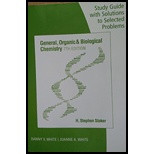
Concept explainers
(a)
Interpretation:
Structural formula for the parent amine from which the substituted ammonium ion is formed has to be drawn.
Concept Introduction:
Substituted ammonium ion is the one in which one or more alkyl, aryl, or cycloalkyl groups are substituted instead of hydrogen atoms. There are two important generalizations that is applied to the substituted ammonium ion and they are,
- Substituted ammonium ions are not neutral molecules. They are charged species.
- Nitrogen atom has four bonds in ammonium ion or substituted ammonium ion. The species is positively charged as the fourth bond formed is a coordinate covalent bond.
(b)
Interpretation:
Structural formula for the parent amine from which the substituted ammonium ion is formed has to be drawn.
Concept Introduction:
Amines are a class of organic compounds. They are derivatives of ammonia. Similar to the nitrogen atom in ammonia, the amine nitrogen also has a lone pair of electrons on it. This means that amines can act as proton acceptors. When an amine is added to water a proton is transferred to the nitrogen atom. The resulting solution is a basic solution. This contains ammonium ions and hydroxide ions.
Substituted ammonium ion is the one in which one or more alkyl, aryl, or cycloalkyl groups are substituted instead of hydrogen atoms. There are two important generalizations that is applied to the substituted ammonium ion and they are,
- Substituted ammonium ions are not neutral molecules. They are charged species.
- Nitrogen atom has four bonds in ammonium ion or substituted ammonium ion. The species is positively charged as the fourth bond formed is a coordinate covalent bond.
(c)
Interpretation:
Structural formula for the parent amine from which the substituted anilinium ion is formed has to be drawn.
Concept Introduction:
Amines are a class of organic compounds. They are derivatives of ammonia. Similar to the nitrogen atom in ammonia, the amine nitrogen also has a lone pair of electrons on it. This means that amines can act as proton acceptors. When an amine is added to water a proton is transferred to the nitrogen atom. The resulting solution is a basic solution. This contains ammonium ions and hydroxide ions.
Substituted ammonium ion is the one in which one or more alkyl, aryl, or cycloalkyl groups are substituted instead of hydrogen atoms. There are two important generalizations that is applied to the substituted ammonium ion and they are,
- Substituted ammonium ions are not neutral molecules. They are charged species.
- Nitrogen atom has four bonds in ammonium ion or substituted ammonium ion. The species is positively charged as the fourth bond formed is a coordinate covalent bond.
(d)
Interpretation:
Structural formula for the parent amine from which the substituted anilinium ion is formed has to be drawn.
Concept Introduction:
Amines are a class of organic compounds. They are derivatives of ammonia. Similar to the nitrogen atom in ammonia, the amine nitrogen also has a lone pair of electrons on it. This means that amines can act as proton acceptors. When an amine is added to water a proton is transferred to the nitrogen atom. The resulting solution is a basic solution. This contains ammonium ions and hydroxide ions.
Substituted ammonium ion is the one in which one or more alkyl, aryl, or cycloalkyl groups are substituted instead of hydrogen atoms. There are two important generalizations that is applied to the substituted ammonium ion and they are,
- Substituted ammonium ions are not neutral molecules. They are charged species.
- Nitrogen atom has four bonds in ammonium ion or substituted ammonium ion. The species is positively charged as the fourth bond formed is a coordinate covalent bond.
Want to see the full answer?
Check out a sample textbook solution
Chapter 17 Solutions
Study Guide with Selected Solutions for Stoker's General, Organic, and Biological Chemistry, 7th
- What is behavioral adaptarrow_forward22. Which of the following mutant proteins is expected to have a dominant negative effect when over- expressed in normal cells? a. mutant PI3-kinase that lacks the SH2 domain but retains the kinase function b. mutant Grb2 protein that cannot bind to RTK c. mutant RTK that lacks the extracellular domain d. mutant PDK that has the PH domain but lost the kinase function e. all of the abovearrow_forwardWhat is the label ?arrow_forward
- Can you described the image? Can you explain the question as well their answer and how to get to an answer to an problem like this?arrow_forwardglg 112 mid unit assignment Identifying melting processesarrow_forwardGive only the mode of inheritance consistent with all three pedigrees and only two reasons that support this, nothing more, (it shouldn't take too long)arrow_forward
- Oarrow_forwardDescribe the principle of homeostasis.arrow_forwardExplain how the hormones of the glands listed below travel around the body to target organs and tissues : Pituitary gland Hypothalamus Thyroid Parathyroid Adrenal Pineal Pancreas(islets of langerhans) Gonads (testes and ovaries) Placentaarrow_forward
 Anatomy & PhysiologyBiologyISBN:9781938168130Author:Kelly A. Young, James A. Wise, Peter DeSaix, Dean H. Kruse, Brandon Poe, Eddie Johnson, Jody E. Johnson, Oksana Korol, J. Gordon Betts, Mark WomblePublisher:OpenStax College
Anatomy & PhysiologyBiologyISBN:9781938168130Author:Kelly A. Young, James A. Wise, Peter DeSaix, Dean H. Kruse, Brandon Poe, Eddie Johnson, Jody E. Johnson, Oksana Korol, J. Gordon Betts, Mark WomblePublisher:OpenStax College- Essentials of Pharmacology for Health ProfessionsNursingISBN:9781305441620Author:WOODROWPublisher:Cengage
 Human Biology (MindTap Course List)BiologyISBN:9781305112100Author:Cecie Starr, Beverly McMillanPublisher:Cengage Learning
Human Biology (MindTap Course List)BiologyISBN:9781305112100Author:Cecie Starr, Beverly McMillanPublisher:Cengage Learning





